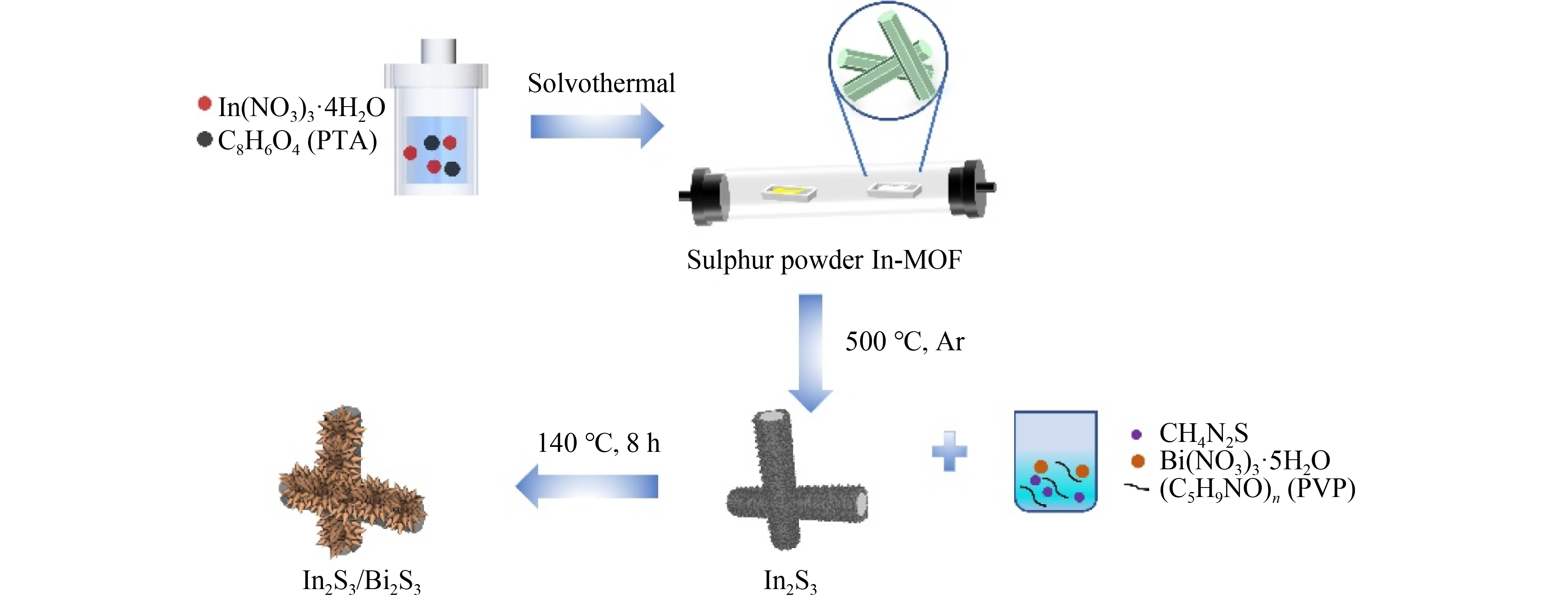

In-MOF-derived In2S3/Bi2S3 heterojunction for enhanced photocatalytic hydrogen production
Received date: 04 May 2023
Accepted date: 31 May 2023
Published date: 15 Oct 2023
Copyright
Transition metal sulfides are commonly studied as photocatalysts for water splitting in solar-to-fuel conversion. However, the effectiveness of these photocatalysts is limited by the recombination and restricted light absorption capacity of carriers. In this paper, a broad spectrum responsive In2S3/Bi2S3 heterojunction is constructed by in-situ integrating Bi2S3 with the In2S3, derived from an In-MOF precursor, via the high-temperature sulfidation and solvothermal methods. Benefiting from the synergistic effect of wide-spectrum response, effective charge separation and transfer, and strong heterogeneous interfacial contacts, the In2S3/Bi2S3 heterojunction demonstrates a rate of 0.71 mmol/(g∙h), which is 2.2 and 1.7 times as much as those of In2S3 (0.32 mmol/(g∙h) and Bi2S3 (0.41 mmol/(g∙h)), respectively. This paper provides a novel idea for rationally designing innovative heterojunction photocatalysts of transition metal sulfides for photocatalytic hydrogen production.

Sibi LIU , Yijin WANG , Youzi ZHANG , Xu XIN , Peng GUO , Dongshan DENG , Jahan B. GHASEMI , Miao WANG , Ruiling WANG , Xuanhua LI . In-MOF-derived In2S3/Bi2S3 heterojunction for enhanced photocatalytic hydrogen production[J]. Frontiers in Energy, 2023 , 17(5) : 654 -663 . DOI: 10.1007/s11708-023-0885-5
| 1 |
Shi X, Dai C, Wang X.
|
| 2 |
Liu Y, Zhang M, Wang Z.
|
| 3 |
Wan J, Liu L, Wu Y.
|
| 4 |
Meng A, Zhang L, Cheng B.
|
| 5 |
Cheng C, He B, Fan J.
|
| 6 |
Wang Y, Huang W, Guo S.
|
| 7 |
Jiang Z, Ye Z, Shangguan W. Recent advances of hydrogen production through particulate semiconductor photocatalytic overall water splitting. Frontiers in Energy, 2022, 16(1): 49–63
|
| 8 |
Liu J, Wei Z, Shangguan W. Enhanced photocatalytic water splitting with surface defective SrTiO3 nanocrystals. Frontiers in Energy, 2021, 15(3): 700–709
|
| 9 |
Huang H, Jiang X, Li N.
|
| 10 |
Taghinejad H, Taghinejad M, Eftekhar A A.
|
| 11 |
Zhang S, Liu X, Liu C.
|
| 12 |
Ma D, Wang Z, Shi J W.
|
| 13 |
Gao D, Xu J, Wang L.
|
| 14 |
Guo S, Luo H, Duan X.
|
| 15 |
Chen W, Liu X, Wei S.
|
| 16 |
Rashidi S, Caringula A, Nguyen A.
|
| 17 |
Xu Z, Zhu Q, Xi X.
|
| 18 |
Li X, Garlisi C, Guan Q.
|
| 19 |
Wang Z, Li C, Domen K. Recent developments in heterogeneous photocatalysts for solar-driven overall water splitting. Chemical Society Reviews, 2019, 48(7): 2109–2125
|
| 20 |
Li X, Yu J, Jaroniec M. Hierarchical photocatalysts. Chemical Society Reviews, 2016, 45(9): 2603–2636
|
| 21 |
Dong G, Qiu P, Meng F.
|
| 22 |
Jiang H, Xing Z, Zhao T.
|
| 23 |
Zuo G, Wang Y, Teo W L.
|
| 24 |
Miodyńska M, Mikolajczyk A, Bajorowicz B.
|
| 25 |
Huang H, Zhang J, Tang C.
|
| 26 |
Hua E, Jin S, Wang X.
|
| 27 |
Sun X, Li L, Hu T.
|
| 28 |
Zhang Y, Huang J, Ding Y. Porous Co3O4/CuO hollow polyhedral nanocages derived from metal-organic frameworks with heterojunctions as efficient photocatalytic water oxidation catalysts. Applied Catalysis B: Environmental, 2016, 198: 447–456
|
| 29 |
Xu H, Yang Y, Yang X.
|
| 30 |
Wang F, Feng T, Jin X.
|
| 31 |
Zhang H, Xin S, Li J.
|
| 32 |
Hong W, Kitta M, Xu Q. Bimetallic MOF-derived FeCo-P/C nanocomposites as efficient catalysts for oxygen evolution reaction. Small Methods, 2018, 2(12): 1800214–1800219
|
| 33 |
Deng Y, Chi B, Li J.
|
| 34 |
Chen C H, Lin S H, Wu Y J.
|
| 35 |
Wu K, Xu G, Pan D.
|
| 36 |
Li C, Li X J, Zhao Z Y.
|
| 37 |
Cheng Y, Wen C, Sun Y Q.
|
| 38 |
Liu J, Zhu D, Guo C.
|
| 39 |
Liu G, Feng K, Cui H.
|
| 40 |
Wang T S, Liu X, Wang Y.
|
| 41 |
Zhang Q, Zhang J, Wang X.
|
| 42 |
Zhang G, Hou S, Zhang H.
|
| 43 |
Sui X, Huang X, Pu H.
|
| 44 |
Cho W, Lee H J, Oh M. Growth-controlled formation of porous coordination polymer particles. Journal of the American Chemical Society, 2008, 130(50): 16943–16946
|
| 45 |
He D, Liu J, Zhang B.
|
| 46 |
Ghoreishian S M, Ranjith K S, Park B.
|
| 47 |
Xu H, Wang Y, Dong X.
|
| 48 |
Yuan X, Jiang L, Liang J.
|
| 49 |
Chen C, Cai W, Long M.
|
| 50 |
Zhang W, Sun X, Sun Z.
|
| 51 |
Wang H, Yuan X, Wu Y.
|
| 52 |
Ai L, Wang L, Xu M.
|
| 53 |
Wang Y, Guo S, Xin X.
|
| 54 |
Zhang Y, Guo S, Xin X.
|
| 55 |
Wang W N, Zhang C Y, Zhang M F.
|
| 56 |
Gao H, Yang H, Xu J.
|
| 57 |
Li Y, Yang M, Xing Y.
|
/
| 〈 |
|
〉 |